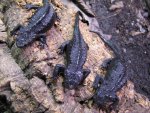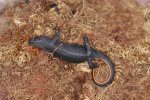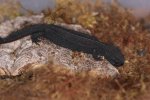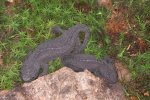So using the description of
T.notialis as reference...
Last pictures are clearly
T.wenxianensis, as stated.
Previous pictures...
Not
T.notialis - diagnostic color of parotids is lacking. Also lacks rib coloration and enlarged rib nodules. Note that rib and parotid color IS visible in at least some
T.vietnamensis.
That leaves
T.asperrimus, T.hainanensis, T.vietnamensis, T.sp. Cao Bang
, T.wenxianensis.
Not
T.vietnamensis - skin is dark and warty rather than smooth and light. Nodules are also not distinct but flattened.
That leaves
T.asperrimus, T.hainanensis, T.sp. Cao Bang
, T.wenxianensis.
Not
T.asperrimus - nodules are not enlarged and knob-like.
That leaves
T.hainanensis, T.sp. Cao Bang
, T.wenxianensis.
Not
T.hainanensis or
T.sp. Cao Bang - nodules are not distinct but flattened
That leaves
T.wenxianensis, which has the trait of nodules being indistinct
, in addition to warty skin, dark coloration, and a lack of color on either parotids or rib nodules
.
One picture of
T.hainanensis online, apparently taken at a locality in the wild, shows rib nodules which are distinctly raised individually above the lateral ridge. I take that image to be representative of certain members of the species
.
CalPhotos: Tylototriton hainanensis; Hainan Knobby Newt
Many pictures of
T.asperrimus online lack locality information, and furthermore lack any distinctive rib nodules. I would identify most of these as
T.wenxianensis.
CalPhotos: Tylototriton asperrimus; Black Knobby Newt
One picture online identified as
T.asperrimus, has obvious diagnostic features of that species, and was recorded from Ha Giang. That places it near the type locality of the species, in Guizhou, China. I would consider this image to be typical
T.asperrimus.
CalPhotos: Tylototriton asperrimus; Black Knobby Newt
Based on published information, I would treat
T.vietnamensis and
T.sp. Cao Bang as being identical except for coloration. Online photos appear to include both true
T.vietnamensis:
http://calphotos.berkeley.edu/cgi/img_query?enlarge=1111+1111+1111+4497
and animals I hesitate to identify:
http://calphotos.berkeley.edu/cgi/img_query?enlarge=1111+1111+1111+4188
That looks more like
T.wenxianensis, but it has the proportions of a juvenile, so I would be reluctant to assign an ID until it had developed adult color and morphology.
Based on published photos and biogeography, I would consider animals of northern Thailand to be
T.shanjing. I would consider animals of northeastern Thailand and probably adjacent Laos to be an undescribed species, differentiated from the previous by smaller size, less developed crests, black limbs, and laterally black tail. Orange coloration is otherwise nearly identical.






